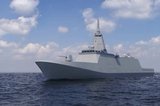Details of GRSE’s small anti-submarine corvette emerge
The Indian Navy’s (IN) Anti-Submarine Warfare Shallow Water Craft (ASWSWC) project of 16 hulls will be split evenly between two shipbuilders, Cochin Shipyard Limited (CSL) and Garden Reach Shipbuilders & Engineers (GRSE).
Each shipyard will build its own variant of a 700t waterjet-powered ASW corvette working to common IN-issued specifications. The ASWSWC is intended for coastal ASW missions, minelaying and maritime security operations within 200nm of the coastline.
While CSL revealed broad specifications of its variant earlier this year, details of GRSE’s ship emerged recently as it seeks vendors to perform basic design work and specialised engineering studies on the proposed design. Given their association with GRSE’s existing projects, Kockums/Saab, Naval Group and Fincantieri are likely contenders.
GRSE’s design has an overall length of 77m, beam of 10.5m and displaces about 750t. It has elements of the X-shaped hull form used in the Kamorta-class corvette.
CSL’s design is slightly shorter at 74m, and it has a beam of 10.5m and somewhat different topside arrangement with slab sides. Otherwise, performance figures and overall propulsion system configuration is similar to GRSE’s. Both have three diesel-driven waterjet units, a top speed of 25kt and range of 1,800nm at 14kt. They will be the biggest waterjet-powered vessels in the IN.
Combat systems include one ASW rocket launcher, two sets of torpedo tubes, small-calibre cannon, mine-laying rails, hull-mounted sonar and towed low-frequency variable-depth sonar. Given its ASW focus, signature management (particularly acoustic silencing) is expected to be a key feature.
An industry source familiar with the project noted that, while the IN would have preferred a common design, GRSE with its large in-house design team is ‘reluctant’ to do so and is pushing ahead with its own variant.
Earlier expectations from GRSE’s management for a contract signing by October did not materialise, but pre-production work is progressing.
Contractually, each shipbuilder is required to build and deliver eight hulls within 84 months. Delivery of the first hull is to be ‘within 42 months’ of contract signing, and subsequent hulls at six-monthly intervals.
More from Naval Warfare
-
![NATO tests use of “undetectable, jam-proof” laser communication in maritime scenarios]()
NATO tests use of “undetectable, jam-proof” laser communication in maritime scenarios
As part of its effort to better prepare its capabilities for operations in contested and congested scenarios, NATO evaluated a Lithuanian ship-to-ship terminal designed to not be susceptible to enemy interference.
-
![Future of the Canadian Patrol Submarine Project is still unclear]()
Future of the Canadian Patrol Submarine Project is still unclear
The Canadian government remains tight-lipped on the timeline and funding required for the next steps of its Canadian Submarine Patrol Project, which should offer improved capabilities for the country’s navy.
-
![Mitsubishi eyes future with Australia’s Mogami selection]()
Mitsubishi eyes future with Australia’s Mogami selection
With Australia’s selection of the Mogami-class for Project Sea 3000, Mitsubishi is investigating local production in the next decade as potential export opportunities emerge.
-
![Thales’ new Sonar 76Nano could equip UK Royal Navy on anti-submarine warfare missions]()
Thales’ new Sonar 76Nano could equip UK Royal Navy on anti-submarine warfare missions
The new sonar is designed to equip uncrewed underwater vessels, with the potential to be used by the Royal Navy for its Atlantic Bastion and Atlantic Net missions.























